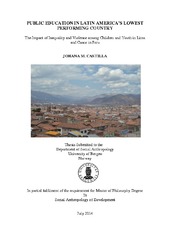Public education in latin america's lowest performing country. The Impact of inequality and violence among children and youth in Lima and Cusco in Peru
Master thesis
Permanent lenke
https://hdl.handle.net/1956/8743Utgivelsesdato
2014-08-01Metadata
Vis full innførselSamlinger
Sammendrag
Measurements of learning outcomes have found that too many children in Peru are graduating from primary school without having achieved competency in literacy or numeracy (Barrett, 2009). Results show that seven out of ten elementary school pupils cannot understand what they read and about nine out of ten struggle doing mathematics at the expected level. In order to raise school performance, state policies have largely focused on improving schools' infrastructures, changing curricular designs and on trying to update the knowledge of teachers. This thesis argues that besides those factors, numerous socioeconomic issues which hamper school performance should be addressed. Among them, inequality (predominantly poverty) and the prevalence of corporal punishment toward children should be acted upon if higher school performance is desired. My argument is that most children and youth try to balance life and school. They study, work and help their families with daily chores. As this desired balance often proves to be unattainable, going to school is perceived as a burden and instills a deep sense of inadequacy among students.
